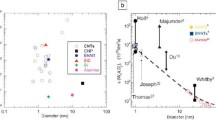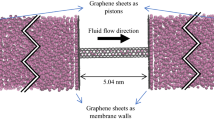Abstract
The flow of a model non-polar liquid through small carbon nanotubes is studied using non-equilibrium molecular dynamics simulation. We explain how a membrane of small-diameter nanotubes can transport this liquid faster than a membrane consisting of larger-diameter nanotubes. This effect is shown to be back-pressure dependent, and the reasons for this are explored. The flow through the very smallest nanotubes is shown to depend strongly on the depth of the potential inside, suggesting atomic separation can be based on carbon interaction strength as well as physical size. Finally, we demonstrate how increasing the back-pressure can counter-intuitively result in lower exit velocities from a nanotube. Such studies are crucial for optimisation of nanotube membranes.
















Similar content being viewed by others
References
Ackerman DM, Skoulidas AI, Sholl DS, Johnson JK (2003) Diffusivities of ar and ne in carbon nanotubes. Mol Simul 29(10–11):677–684
Allen MP, Tildesley D (1987) Computer simulation of liquids. Clarendon Press, Oxford
Arora G, Sandler SI (2005) Air separation by single wall carbon nanotubes: Thermodynamics and adsorptive selectivity. J Chem Phys 123(4):044,705
Arya G, Chang HC, Maginn EJ (2001) A critical comparison of equilibrium, non-equilibrium and boundary-driven molecular dynamics techniques for studying transport in microporous materials. J Chem Phys 115(17):8112–8124
Chen HB, Sholl DS (2006) Predictions of selectivity and flux for ch4/h-2 separations using single walled carbon nanotubes as membranes. J Memb Sci 269(1–2):152–160
Duren T, Keil FJ, Seaton NA (2002a) Composition dependent transport diffusion coefficients of ch4/cf4 mixtures in carbon nanotubes by non-equilibrium molecular dynamics simulations. Chem Eng Sci 57(8):1343–1354
Duren T, Keil FJ, Seaton NA (2002b) Molecular simulation of adsorption and transport diffusion of model fluids in carbon nanotubes. Mol Phys 100(23):3741–3751
Dzubiella J, Allen RJ, Hansen JP (2004) Electric field-controlled water permeation coupled to ion transport through a nanopore. J Chem Phys 120(11):5001–5004
Fang HP, Wan RZ, Gong XJ, Lu HJ, Li SY (2008) Dynamics of single-file water chains inside nanoscale channels: physics, biological significance and applications. J Phys D Appl Phys 41(10):103,002
Hinds BJ, Chopra N, Rantell T, Andrews R, Gavalas V, Bachas LG (2004) Aligned multiwalled carbon nanotube membranes. Science 303(5654):62–65
Holt JK, Park HG, Wang YM, Stadermann M, Artyukhin AB, Grigoropoulos CP, Noy A, Bakajin O (2006) Fast mass transport through sub-2-nanometer carbon nanotubes. Science 312(5776):1034–1037
Hummer G, Rasaiah JC, Noworyta JP (2001) Water conduction through the hydrophobic channel of a carbon nanotube. Nature 414(6860):188–190
Jakobtorweihen S, Verbeek MG, Lowe CP, Keil FJ, Smit B (2005) Understanding the loading dependence of self-diffusion in carbon nanotubes. Phys Rev Lett 95(4):044,501
Jakobtorweihen S, Keil FJ, Smit B (2006) Temperature and size effects on diffusion in carbon nanotubes. J Phys Chem B 110(33):16,332–16,336
Joseph S, Aluru NR (2008) Why are carbon nanotubes fast transporters of water? Nano Lett 8(2):452–458
Kostov MK, Cheng H, Cooper AC, Pez GP (2002) Influence of carbon curvature on molecular adsorptions in carbon-based materials: a force field approach. Phys Rev Lett 89(14):146,105
Lee KH, Sinnott SB (2004) Computational studies of non-equilibrium molecular transport through carbon nanotubes. J Phys Chem B 108(28):9861–9870
Mao ZG, Sinnott SB (2000) A computational study of molecular diffusion and dynamic flow through carbon nanotubes. J Phys Chem B 104(19):4618–4624
Miller SA, Young VY, Martin CR (2001) Electroosmotic flow in template-prepared carbon nanotube membranes. J Am Chem Soc 123(49):12,335–12,342
Nagayama G, Cheng P (2004) Effects of interface wettability on microscale flow by molecular dynamics simulation. Int J Heat Mass Transf 47(3):501–513
Shiomi J, Maruyama S (2009) Water transport inside a single-walled carbon nanotube driven by a temperature gradient. Nanotechnology 20(5):055,708
Skoulidas AI, Ackerman DM, Johnson JK, Sholl DS (2002) Rapid transport of gases in carbon nanotubes. Phys Rev Lett 89(18):185,901
Sun L, Crooks RM (2000) Single carbon nanotube membranes: a well-defined model for studying mass transport through nanoporous materials. J Am Chem Soc 122(49):12,340–12,345
Supple S, Quirke N (2003) Rapid imbibition of fluids in carbon nanotubes. Phys Rev Lett 90(21):214,501
Travis KP, Gubbins KE (2000) Poiseuille flow of lennard-jones fluids in narrow slit pores. J Chem Phys 112(4):1984–1994
Verlet L (1967) Computer experiments on classical fluids. I. Thermodynamical properties of Lennard–Jones molecules. Phys Rev 159(1):98
Zhang ZQ, Zhang HW, Zheng YG, Wang L, Wang JB (2008) Gas separation by kinked single-walled carbon nanotubes: molecular dynamics simulations. Phys Rev B 78(3):035,439
Zhu FQ, Tajkhorshid E, Schulten K (2002) Pressure-induced water transport in membrane channels studied by molecular dynamics. Biophys J 83(1):154–160
Acknowledgments
The authors gratefully acknowledge funding from the EPSRC.
Author information
Authors and Affiliations
Corresponding author
Rights and permissions
About this article
Cite this article
Cannon, J., Hess, O. Fundamental dynamics of flow through carbon nanotube membranes. Microfluid Nanofluid 8, 21–31 (2010). https://doi.org/10.1007/s10404-009-0446-1
Received:
Accepted:
Published:
Issue Date:
DOI: https://doi.org/10.1007/s10404-009-0446-1




